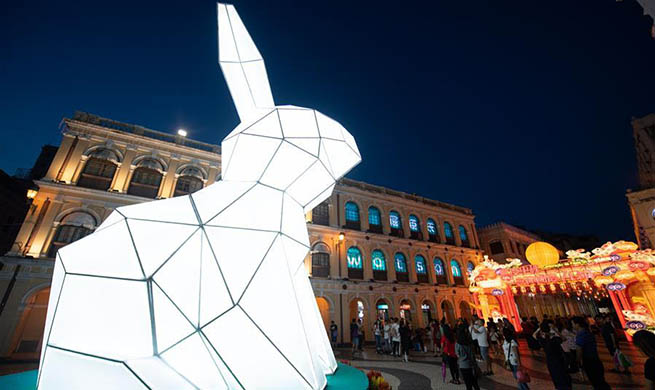by Mahmoud Fouly
LUXOR, Egypt, Sept. 11 (Xinhua) -- The two-floor Luxor Museum overlooking the east bank of the Nile River in the heart of Upper Egypt's monument-rich city of Luxor, a capital in ancient Egypt known as Thebes, is a unique landmark for exploring the history of ancient Egypt through different eras.
The museum was opened for visitors in 1975 by late Egyptian President Anwar Sadat, accompanied by former French President Valery Giscard d'Estaing.
Built on an area of more than 5,300 square meters, Luxor Museum consists of a garden with four human-size statues and a two-floor building with six halls displaying around 2,200 artifacts covering ancient Egyptian eras, including Pharaonic, Greco-Roman, Coptic and Islamic periods.
Still, the Pharaonic antiquities are the most eye-catchy in the museum.
To the left side of the museum's main gate, the garden with its four statues acts as a pathway to the museum's door, preparing the visitors to the magnificent ancient atmosphere waiting for them inside.
The first statue in the garden is a standing one of King Ramses II, the next is a sitting one of King Amenhotep III, the third is a standing one of King Merenptah and the last is another sitting statue of Amenhotep III.
"There was another statue of Amenhotep III but it was moved in early 2018 to the Grand Egyptian Museum (GEM) that is scheduled to be opened in 2020," said Samia Abdel-Aziz, Luxor Museum's general manager.
She added that the museum has new additions every now and then to maintain its glory, noting that the hall of statue cache was added in 1991 and later in 2004 the extension of Thebes' Military-Technology Glory was added.
"The most recent addition is this huge coffin of Queen Tausert of the New Kingdom of ancient Egypt. This hall that contains the coffin is called Sobek hall, which is named after that statue combining crocodile god Sobek with King Amenhotep III over there," Abdel-Aziz told Xinhua at Sobek hall.
The interior of the dimly-lit museum is smooth as it depends on ascending and descending ramps with no stairways to connect between its two levels. It is more like a ring road through which a visitor can tour the whole museum and see all the objects.
It is also distinguished by a balcony-like interior design that enables visitors in the upper floor to see the lower one.
Ellen Mulder, an old lady from the Netherlands who was touring the museum, said that she was curious to come and visit Egypt for the first time after seeing an exhibition of Egyptian antiquities at her country.
"We learned a lot about Egypt over there and we were very curious to come to Luxor. The museum here is amazing and I liked all the statues inside. They are really so artistically-shaped and very special," the lady told Xinhua.
Inside the museum building, just on the right side of the main door, a huge granite head of Amenhotep III is displayed, and the opposite side shows a granite head of King Senusret III followed by a headless black granite statue of vizier Mentuhotep seated in a position preparing to write.
A group of three British young men seemed impressed while exploring some of the displayed Pharaonic artifacts in the museum and reading the captions attached to each.
"We went to Karnak Temple Complex in Luxor earlier today and saw lots of huge columns and many statues, so we've come to Luxor Museum today to complete the picture," Edward Grace, a British university student in his 20s, told Xinhua on Monday.
"I would definitely recommend visiting Egypt to my friends in England, particularly Luxor and its unique museum," he added.
The rare antiquities in the museum include a limestone statue of god Amun with the facial features of world-famous young King Tutankhamun, a calcite sphinx with a broken head lying in a position of presenting offerings, a small obelisk belonging to King Ramses III, a sandstone stela depicting King Ramses III presenting offering to god Amun-Ra.
Most of them belonged to the New Kingdom and the Middle Kingdom of ancient Egypt, from about 3,100 to 4,000 years ago.
Tens of pieces belonging to King Tut were moved from Luxor Museum to the GEM in Giza to be displayed during its soft opening, which is expected in late 2020.
"All the artifacts featured in Luxor Museum belonged to ancient people who lived in Luxor and affected or were affected by the city. So, it is a real representative of Luxor history and culture," said Sana Ahmed Ali, director-general of Upper Egypt's museums.
Other unique artifacts are also displayed in the museum such as a large statue of King Thutmose III seated on the throne, a head of a statue of King Amenhotep I, a bust of King Amenhotep II, a statue of King Amenhotep III, a bust and a head of a statue of King Akhenaton, a double statue of god Amun and his wife goddess Mut.
"Tourists in Luxor can choose between more than 600 sites, such as royal temples and tombs including those in the Valley of the Kings and the Valley of the Queens. When they are attracted to visit Luxor Museum among all those sites, it means that the museum has succeeded in its main mission," she told Xinhua at the museum.
Most visitors wouldn't leave Sobek hall without being attracted to take a look at that massive six-ton coffin of Queen Tausert, the latest piece brought to Luxor Museum.
Mostafa Waziri, secretary-general of the Supreme Council of Antiquities, said that the coffin was located in Luxor's west bank since its discovery about 26 years ago before being moved to the museum.
The coffin is about 120 cm wide, 280 cm long and 150 cm high.
"Luxor Museum is one of the most beautiful museums nationwide. As the Ministry of Antiquities, we always try to add something new to the museum to impress the recurrent visitors in each visit," Waziri told Xinhua near the coffin.
Besides featured colorful coffins and several mummies displayed in the museum, "Thebes' Glory" hall showcases two small models of ancient boats with rowers, passengers and sailors inside.
The museum is not only frequented by foreigners, but many Egyptian visitors, particularly Luxor residents, who can be seen around its different halls.
"It's not my first time to visit Luxor Museum. Many people of Luxor like to visit the museum and also encourage and teach their children to visit it and be proud of their history and heritage," Adham Haggag, a 26-year-old visitor from Luxor, told Xinhua during his tour inside the museum.













